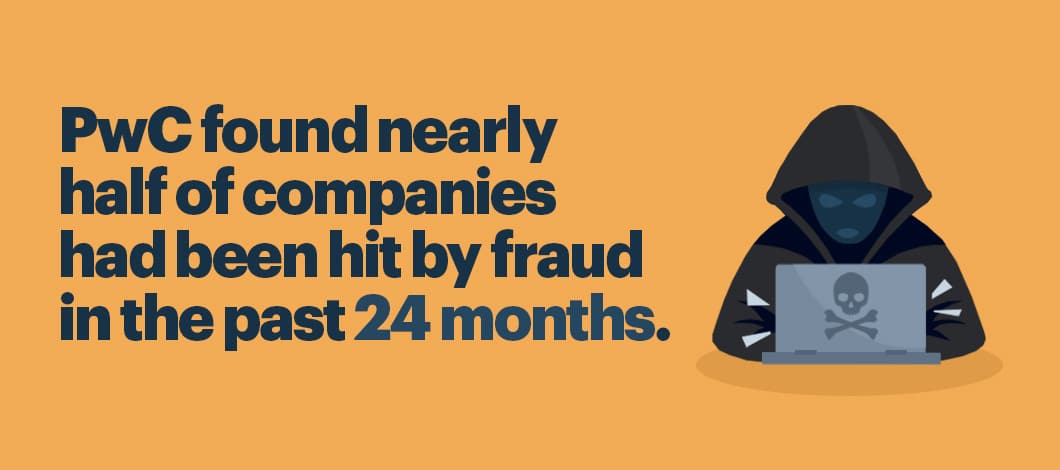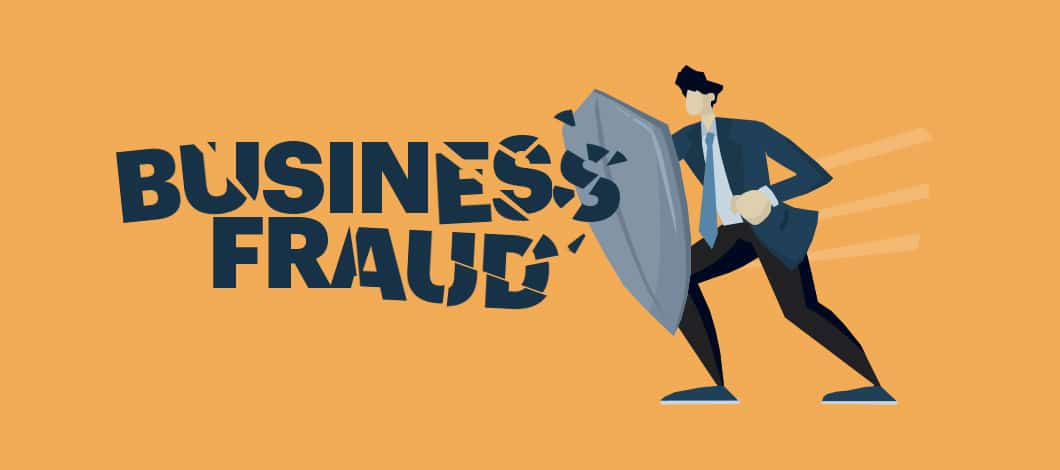Knowing how to prevent fraud in business can save you money and shield you from liability. Here’s how to protect your company from fraud.
We’ll look at what business fraud is and what types of fraud to watch out for. Then we’ll offer 5 best practices for preventing fraud.
What Is Business Fraud?
According to the Federal Bureau of Investigation (FBI), business fraud, also known as corporate fraud or occupational fraud, transpires when individuals or companies commit dishonest and illegal activities for financial gain. Perpetrators of business fraud typically use the appearance of ordinary business practices to commit their crimes. Business fraud may be targeted at consumers or at businesses themselves. We’ll be focusing on types of occupational fraud that target businesses rather than consumers.
The Causes
Causes of fraud in companies can stem from both internal and external sources. Internal sources of fraud include owners and managers who misappropriate company assets and employees who steal from their employers. External sources of fraud include dishonest contractors, customers who scam companies and cyberattacks. In some cases, criminals outside a company conspire with insiders to rob businesses.
The impact of fraud on the company and business sector is enormous. A 2020 global survey by professional services provider PwC found nearly half of companies had been hit by fraud over the past 24 months, with the average company experiencing 6 incidents during that interval. Financially, the total effects of frauds in business added up to $42 billion, with 13% of companies reporting losses of $50 million or more.

Types of Fraud in Business
Types of frauds perpetrated against businesses fall into a few major categories. According to an annual report by the Association of Certified Fraud Examiners (ACFE), a leading antifraud organization, the most common business frauds examples include:
- Asset misappropriation (involved in 86% of occupational fraud cases)
- Corruption (43%)
- Financial statement fraud (10%)
While asset misappropriation is the most common category of fraud, financial statement fraud accounts for the largest median losses. Median loss in asset misappropriation cases is $100,000, compared with $200,000 for corruption and $954,000 for financial statement fraud.
Asset Misappropriation
Asset misappropriation involves employees stealing or misusing company assets.
Examples include:
- Stealing cash from sources such as cash registers before reporting it
- Claiming false expense reports
- Taking noncash assets, such as stealing inventory
These types of crimes typically are committed by employees and result in lower losses than other categories.
Corruption
Corruption involves employees, managers or owners misusing their position and influence for financial gain.
Examples include:
- Conflicts of interest, such as an employee responsible for purchases misusing their position to buy merchandise for themselves
- Bribery, such as exploiting a position for kickbacks or rigging contract bids
- Illegal gratuities, such as accepting payment to overlook a compliance requirement
These types of crimes often involve company members in management or ownership positions, which can make them more costly than asset misappropriation incidents.
Financial Statement Fraud
Financial statement fraud occurs when a company member causes a material misstatement or omission to be entered into company financial statements.
Examples include:
- Overstating income by exaggerating the value of assets or concealing liabilities
- Understating net worth in order to conceal assets or exaggerate liabilities
This type of fraud typically involves owners, accountants or other individuals with access to company financial statements. This can make financial statement fraud more sophisticated and costly than other types of fraud.
How to Prevent Fraud in Business
Fraud management encompasses a number of strategies and best practices. Some of the most important include:
- Consulting antifraud experts
- Screening business partners and employees
- Setting up fraud control procedures
- Using visible fraud monitoring systems
- Creating fraud reporting systems
The exact way these strategies are implemented will vary by company size, industry and other factors, but some general guidelines are summarized below.
1. Consult Antifraud Experts
Fraud schemes can be hard to detect if you aren’t experienced. Consulting an expert can help you identify your vulnerabilities and select appropriate responses.
Important categories of consultants to consider include:
- Certified fraud examiners (CFEs), antifraud professionals certified by the ACFE
- Certified public accountants (CPAs), who can spot accounting procedures that lend themselves to fraud
- CPAs who are Certified in Fraud Forensics (CFF), a special certification of anti-fraud expertise issued by the Association of International Certified Professional Accountants (AICPA), an international member association representing the accounting profession
Consulting a qualified expert can help you implement the other steps recommended here more efficiently and effectively.
2. Screening Business Partners and Employees
Knowing your business partners and employees can help you reduce fraud risk. Before entering into a business partnership, perform due diligence by doing a comprehensive background check which covers items such as your prospective partner’s criminal record, finances and civil litigation history. New hires also should be screened for criminal backgrounds.
Screening partners and employees should be an ongoing rather than a one-time affair. Keep an eye out for partners or employees who show signs of being disgruntled or engaging in suspicious behavior. Don’t overlook employees who seem like perfect workers, either. For example, an embezzler may never take a vacation so that they can keep others from looking at company books. Create standard procedures for monitoring fraud risks on an ongoing basis.

3. Set Up Fraud Control Procedures
Establishing standard fraud control procedures plays a critical role in preventing fraud. Such procedures include internal controls to prevent fraud as well as external procedures such as audits.
Important internal fraud and external fraud control measures include:
- Cash counting procedures for monitoring employee handling of cash and verifying amounts
- Expense reporting procedures that include receipt requirements and supervisors signing off on expenses
- Access control to define who can view and update company financial records
- Use of multiple accountants on a rotating basis to make sure that no one individual has exclusive access to company books
- Mandatory periodic vacations for employees and officers in positions at risk of fraud
- Strong digital security procedures
- Periodic bank account reviews to flag items such as missing checks, checks with unknown recipients and undeposited checks signed over to third parties
- Regular internal and external audits
- Periodic unscheduled audits
An antifraud expert can help you determine which procedures are most relevant for your company.
4. Use Visible Fraud Monitoring Systems
Individuals are less likely to attempt fraud if they know they are being monitored and are at risk of getting caught. Implementing fraud monitoring systems and making company members aware of them will help discourage fraudulent activity. Educate your managers and employees about what steps you have in place to detect fraud and what the consequences of detection will be.
5. Create a Fraud Reporting System
Your fraud monitoring systems should be supplemented by systems and procedures for reporting fraud. For example, you can create a fraud reporting hotline, an email account or a procedure for reporting suspected fraud to designated security personnel. Train your employees to spot signs of suspicious behavior and how to report business fraud.
Don’t Let Fraud Rob Your Company’s Assets
Fraud tactics such as asset misappropriation, corrupt and financial statement fraud cost companies billions of dollars a year, with some incidents costing individual companies millions of dollars.
Fortunately, you can reduce fraud risk by taking steps such as consulting anti-fraud experts, screening business partners and employees, setting up fraud control procedures and setting up systems for monitoring and reporting fraud. How to prevent fraud in business? Use these best practices to protect your company’s assets from would-be thieves.










